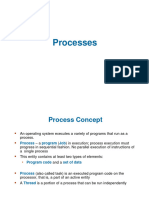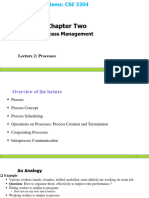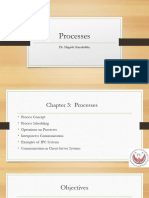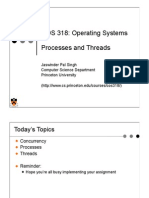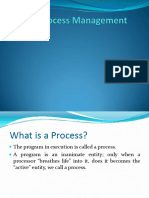0% found this document useful (0 votes)
115 views69 pagesOperating Systems: Processes & Threads
The document discusses processes and threads. It defines a process as a program in execution that consists of one or more threads. Key points made include:
- Processes are the fundamental concept in operating systems and are the unit of scheduling and resource allocation.
- Process state includes registers, memory, I/O devices, and more. Process management involves allocating resources, facilitating multiprogramming, and protecting resources.
- Processes have states like running, ready, blocked, and more. Scheduling moves processes between these states.
- A process image includes the program code, data, stack, and process control block with scheduling information.
- Common process operations are creation via fork, termination via
Uploaded by
Ayi AlfredCopyright
© © All Rights Reserved
We take content rights seriously. If you suspect this is your content, claim it here.
Available Formats
Download as PDF, TXT or read online on Scribd
0% found this document useful (0 votes)
115 views69 pagesOperating Systems: Processes & Threads
The document discusses processes and threads. It defines a process as a program in execution that consists of one or more threads. Key points made include:
- Processes are the fundamental concept in operating systems and are the unit of scheduling and resource allocation.
- Process state includes registers, memory, I/O devices, and more. Process management involves allocating resources, facilitating multiprogramming, and protecting resources.
- Processes have states like running, ready, blocked, and more. Scheduling moves processes between these states.
- A process image includes the program code, data, stack, and process control block with scheduling information.
- Common process operations are creation via fork, termination via
Uploaded by
Ayi AlfredCopyright
© © All Rights Reserved
We take content rights seriously. If you suspect this is your content, claim it here.
Available Formats
Download as PDF, TXT or read online on Scribd
/ 69



